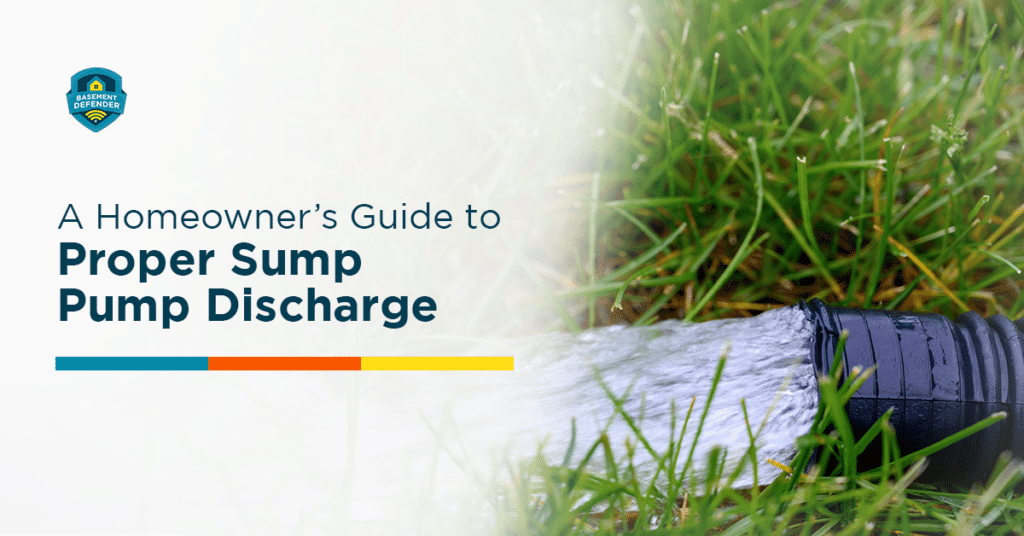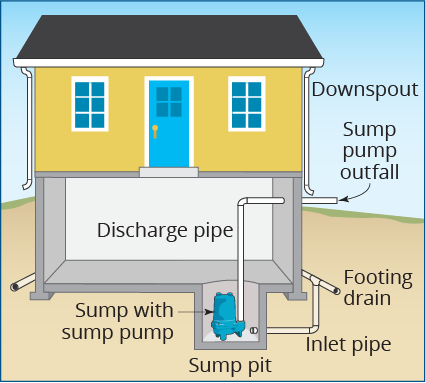
Water accumulation under your home—whether from those strong Midwestern and East Coast floods or seepage from high water tables—is bad news. Installing a sump pump in your basement or crawl space can help remove this water from your home and prevent basement flooding.
Given that, a key aspect of the sump pump system is its discharge process. Your sump pump discharge kit is useless without a properly designed sump pump discharge that will help prevent basement flooding, erosion, freezing, and other similar issues threatening your health and safety.
A proper discharge system can also save you from expensive repairs, as water damage costs can reach up to $10,000 or more. As a homeowner, you must know how your discharge system works to safeguard your home effectively.
This article will serve as a guide on sump pump discharges and how to avoid the common mistakes that many first-time homeowners and sump pump owners make.

The sump pump discharge line carries water from the sump pit away from your house, this keeps the water from recirculating in your sump pit as well as preventing foundation issues. The ideal area for sump pumps to discharge the collected water are grassy areas that slope outwards from your home or directly into a city storm drain system.
As straightforward as the process may be, it can still go wrong in several ways. Dirt and debris from an uncleaned sump pump discharge line can clog and block outward-flowing water. A cold climate can also cause your sump pump discharge line to freeze if not installed correctly.
Clogged sump pumps can cause basement flooding. Thus, it’s worthwhile to understand how to set up your sump pump discharge kit and system properly to ensure it works, especially when needed.
Besides the installation process, below are a few things you need to consider to ensure your sump pump system is discharging properly.
The best practice for sump pump water discharge is to direct it away from your house. Although not all places are acceptable as sump pump discharge locations, many first-time homeowners aren’t aware of local codes that prohibit discharging near property lines, into septic systems, or directly onto the street or sidewalk.
To avoid city code violations, look for land areas with downhill slope. Storm drains are ideal areas to discharge accumulated water. You can always consult with sump pump experts to learn where you can and can’t have your sump pump discharge.
Sump pump discharge area should be 10 to 20 feet away from your house’s foundation. While some may think that “the farther, the better,” using pipes longer than 20 feet of internal discharge piping risks overworking the sump pump’s motor capacity to push water out.
Similarly, using a pipe with a narrow diameter can lead to flow problems. Instead, use the accepted discharge pipe size depending on your local codes. Hiring a sump pump expert is a good idea to ensure your pump’s correct installation and functionality.
Storm season isn’t the only time to consider your sump pump’s health. During winter, snow or frozen water can clog your sump pump discharge line, potentially overworking the motor and leading to basement water accumulation.
Once the temperature increases again, snowmelt becomes a greater concern. Heavy spring rains can also pose a problem when the ground is frozen since flooding is even more likely. An effective way to protect your sump pump discharge line from colder climates is to insulate it as much as possible.
Burying the discharge line below the frost line, which can vary by state (around 40 inches in Illinois), and installing an air gap at the point of discharge that will allow any pumped water to overflow onto the ground around the discharge pipe, which will prevent the pump from burning up due to an ice blockage in the discharge line.
Daily testing of your sump pump is crucial for prolonging its life span and ensuring it will work during a storm event. Be sure to frequently test your sump pump’s discharge line to ensure proper function and that there are no restrictions. You can also pour water into the sump pump’s pit to test the system’s efficiency in discharging water.
Smart sump pump monitoring systems greatly enhance maintenance convenience. The sump pump Wi-Fi monitoring daily testing features found in modern sump pump smart kits allow you to closely monitor your sump pump’s health, as well as its run time history without needing to be home and physically inspect your sump pump system.
You’ll need to follow legal building code standards when installing your sump pump discharge line, which can differ depending on where you are on the Midwest or East Coast.
For instance, Galesburg, Illinois codes require a minimum distance of 10 feet between the sump pump discharge and the public right-of-way. While the Chicago code doesn’t explicitly share the same guidelines, it does include sump pump design standards to follow.
It’s best to work with professionals to help you ensure that your sump pump discharge kit is up to legal standards.
Bubbler pots are an ideal solution when dealing with a flat yard or the absence of a nearby storm drain connection. These devices operate like an overflowing boiling pot if you’re cooking.
They’re attached at the end of a buried pipe and rise, peeking out from under the surface and flush with your yard. Once the water reaches it, its lid pops up, allowing water to discharge around it.
Excess water beneath your house can cause significant long-term damage and costly repairs. As such, your sump pump discharge must work properly and be ready to handle any potential flooding in your basement or crawl space.
While following the tips above can help maximize your sump pump’s effectiveness, it wouldn’t do you much good if your pump is faulty or low-quality. For enhanced protection against water damage, consider exploring the range of Basement DefenderTM products.
We provide various smart sump pump devices to protect your basement or crawl space more effectively from excess water, which can lead to basement flooding. Our products in our Basement DefenderTM store feature smart monitoring systems that test your sump pumps daily, which you can access and receive alert notifications through the Basement DefenderTM app.
That way, you can ensure your sump pump is always working properly, even when you aren’t home. ALL sump pumps fail; it’s just a question of when and how they will fail. If you have any questions or concerns about how Basement DefenderTM can help you, contact us online today!

Roy is a respected authority in the waterproofing industry, with over 40 years of experience under his belt. His company, Perma-Seal, has earned a reputation as Chicagoland’s premier waterproofing contractor, thanks to Roy’s unwavering commitment to quality, integrity, and customer satisfaction.
His latest innovation, the Basement Defender, is a testament to his dedication to providing homeowners with the best possible protection against basement flooding, representing a major leap forward in the industry’s efforts to prevent water damage and save homeowners from costly repairs.